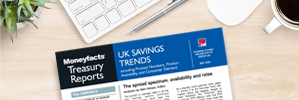Rachel Springall, Finance Expert at Moneyfacts, said:
“Cash ISAs are under threat, with rumours persisting of a cut to the £20,000 yearly allowance, a futile attempt to push risk-averse savers to invest. This year has been a milestone for cash ISAs, with the choice of deals and number of providers in this sector reaching record highs. Savers have flocked to cash ISAs to shield their money from tax, no doubt boosted by worries over a cut to the yearly allowance, with the Bank of England showing almost £30bn of deposits made since the start of April. However, despite the strong start to the new tax-year, the choice of cash ISAs felt its biggest monthly fall since January 2024, and the average easy access ISA and one-year fixed ISA rates are now at their lowest levels in two years.
“Savers find comfort in cash ISAs, particularly those who are being hit by fiscal drag and do not want to risk their pot in a stocks and shares ISA. Indeed, investing the full £20,000 in a one-year fixed cash ISA paying 3.89% would earn £778 in interest after 12 months, which is completely shielded from tax. However, if the same amount was invested in a one-year bond at 3.95%, earning £790, higher-rate taxpayers would breach their yearly Personal Savings Allowance (PSA) of £500, which is half that of the £1,000 limit granted to basic-rate taxpayers.
“If the cash ISA allowance gets cut down to £12,000, not only will it cause chaos from a retail funding perspective, but it will give savers less reason to use a cash ISA in the first place. Maxing out a yearly limit of £12,000 will earn less than £500 in interest based on the current average returns of a one-year cash ISA or fixed bond, currently below 4%, which is within the PSA for both a higher-rate and basic-rate taxpayer. Therefore, unless the PSA is abolished, savers who chase top rate returns would take home more interest outside of a cash ISA and there will be a greater argument for investing in a stocks and shares ISA.
“Interest rates are expected to come down further, and many economists predict another cut to the Bank of England base rate in December. However, when it comes to fixed rates, these are more in tune with swap rates, so providers will be monitoring movements very closely, while also managing their deposit funding targets. Taking time to review and switch any savings account will be essential over the coming months, as will be maximising the use of any tax-free allowances.”
*Survey of 2,000 nationally representative UK adults carried out by OnePoll on behalf of Moneyfacts between 1 - 3 September 2025. Savings index data and analysis can be found here.
Rachel Springall, Finance Expert at Moneyfacts, said:
“Cash ISAs are under threat, with rumours persisting of a cut to the £20,000 yearly allowance, a futile attempt to push risk-averse savers to invest. This year has been a milestone for cash ISAs, with the choice of deals and number of providers in this sector reaching record highs. Savers have flocked to cash ISAs to shield their money from tax, no doubt boosted by worries over a cut to the yearly allowance, with the Bank of England showing almost £30bn of deposits made since the start of April. However, despite the strong start to the new tax-year, the choice of cash ISAs felt its biggest monthly fall since January 2024, and the average easy access ISA and one-year fixed ISA rates are now at their lowest levels in two years.
“Savers find comfort in cash ISAs, particularly those who are being hit by fiscal drag and do not want to risk their pot in a stocks and shares ISA. Indeed, investing the full £20,000 in a one-year fixed cash ISA paying 3.89% would earn £778 in interest after 12 months, which is completely shielded from tax. However, if the same amount was invested in a one-year bond at 3.95%, earning £790, higher-rate taxpayers would breach their yearly Personal Savings Allowance (PSA) of £500, which is half that of the £1,000 limit granted to basic-rate taxpayers.
“If the cash ISA allowance gets cut down to £12,000, not only will it cause chaos from a retail funding perspective, but it will give savers less reason to use a cash ISA in the first place. Maxing out a yearly limit of £12,000 will earn less than £500 in interest based on the current average returns of a one-year cash ISA or fixed bond, currently below 4%, which is within the PSA for both a higher-rate and basic-rate taxpayer. Therefore, unless the PSA is abolished, savers who chase top rate returns would take home more interest outside of a cash ISA and there will be a greater argument for investing in a stocks and shares ISA.
“Interest rates are expected to come down further, and many economists predict another cut to the Bank of England base rate in December. However, when it comes to fixed rates, these are more in tune with swap rates, so providers will be monitoring movements very closely, while also managing their deposit funding targets. Taking time to review and switch any savings account will be essential over the coming months, as will be maximising the use of any tax-free allowances.”
*Survey of 2,000 nationally representative UK adults carried out by OnePoll on behalf of Moneyfacts between 1 - 3 September 2025. Savings index data and analysis can be found here.








